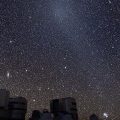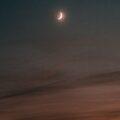For guidance on reading the tables for beginners – please go here
The month begins with the Andromeda Galaxy on our meridian at 8pm. On December 6, Mars rises at 8pm to join Jupiter, Saturn. (Venus set at 7:30pm). Their distances from us cover a wide range: Jupiter Saturn 1.4-billion km, 600-million km, Venus 140-million km and Mars at 115-million km.
The Geminid meteor shower is on the night of the 13/14. These meteors tend to be fast and bright but the near-full Moon will obscure the more plentiful fainter members.
Winter begins with the winter solstice on the morning of December 21. This is longest night of the year. How long depends on your latitude. The most southern point of Canada (Point Pelee, ON) has 13h 41m of “night” (ignoring twilight) with sites north of the arctic circle getting 24 hours.
NOTABLE EVENTS
Dec 1 New Moon 01:21
Dec 6 Mars rises in NE at 8pm
Dec 7 Jupiter at Opposition
Dec 8 First Quarter Moon 10:27
Dec 13 Geminid Meteors
Dec 15 Full Moon 04:02
Dec 17 Sun enters Sagittarius
Dec 18 Mars less than 1/2 deg below gibous Moon at 05:00
Dec 21 Winter Solstice 04:21
Dec 22 Last Quarter Moon 17:18
Dec 24 Mercury at maximum morning Elongation
Dec 30 New Moon 17:27
MONTHLY TABLE

Main Meteor Showers
Meteor showers are best observed after midnight when our hemisphere is ploughing into the meteor stream. Although the duration of the most active portion of the shower is short, some shower meteors can be seen many days on either side of maximum.
The fainter Geminid meteors will be “washed out” by the full Moon, so this will be an unfavourable year.

Dates for the Phases of the Moon

Entries are in Eastern Time and only require time zone correction. Do not use the correction from the “Ottawa-Time” table. Saskatchewan and parts of BC and Ontario do not use daylight savings. In these regions, subtract 1-hour from these times from March 10 to November 3.
Planetary Configurations
When at Opposition, planets will appear on the opposite side of the sky from the Sun – very roughly on the meridian at midnight. Conjunctions are when the planet has the same “longitude” as the Sun. A Superior Conjunction is when the planet is on the other side of the Sun, and an Inferior Conjunction is when it is between the Earth and the Sun. Only Mercury and Venus can be at Inferior Conjunction. Maximum elongation is when Mercury and Venus appear farthest from the Sun in our sky. This occurs either in our morning eastern sky (mor.) or our western evening sky (eve.). Do not apply the Ottawa-correction times to the times in this table.

Prominent Constellations by Seasons


Brightest Stars













